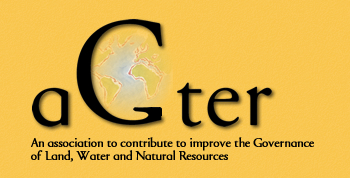
|
These documents are now avaiblable on the online Knowledge Base of AGTER www.agter.org, with an interface especially dedicated to a multilingual knowledge database.
400 years of land despoliations
Although the main objective of the first colonial institutions was to acquire and control the indigenous workforce, notably to work in the mines, the colonists’ interest in land began to increase from the 17th century onwards. The decrease in silver mining profitability and the investment of capital in farming rapidly transformed the colonial hacienda into a major commercial agricultural estate. At first, the hacienda’s organization revolved around the (...)

|

|
[*Past agrarian systems*]
The Viet tribes, ancestors of the contemporary Vietnamese, cultivated terraces, and then the delta of the North Vietnam Red River, and developed their civilisation on the basis of rice cultivation. In the XIth century, they founded the first Vietnamese hydraulic state, after several centuries of Chinese domination. In the XVIth century, the Northern deltas were not enough to feed 5-6 million inhabitants. There were waves of immigration towards the South, heading (...)

|

|
There are many similarities between the colonial and post-colonial agrarian histories of Nicaragua and Honduras. Both countries have been the theatre of ambitious agrarian reforms over the past decades, though carried out in very different political contexts. Their comparative study is very enriching. In the nineties, both countries were subject to structural adjustment policies and the agrarian reform programmes were put to a halt in favour of a return to market practices. In both cases, (...)

|

|
[*The antecedents*]
Honduras is the archetypal banana republic due to the importance of its foreign-owned mines and plantations. The interests of the nation’s dominant social strata have been focused in the North, particularly on the plantations where there has been a very high level of ‘proletarianisation’. Successive military regimes have been in power until recent times.
The colonial history of Honduras is similar to that of Nicaragua. However, it was not until after World War II that the (...)

|

|
[*The antecedents*]
During the colonial period, a small social group made up of mestizos began to form, although the laws in place only recognised “Spanish” and “Indian” members of the population. However, this new group was to make up the greater part of Nicaragua’s peasantry. After the country’s independence (1821), the only way the oligarchy in place and the new dominant classes could maintain their control was to gain possession of most of the land. They achieved this by developing coffee (...)

|

|
[*The collectivist period*]
The establishment of the Communist regime in Albania in 1945 was immediately followed by the adoption of an agrarian reform law. Big landowners were expropriated without compensation and their “exorbitant” capital goods were confiscated, including all vineyards, orchards, gardens, pastures and forests larger than the legally defined limit. In less than two years, Albania’s very unequal land distribution, a product of the Ottoman agricultural structure and “second (...)

|

|
Poland has undergone three big agrarian reforms, which took place in completely different circumstances and following completely different methods. The “Polish land issues laboratory” illustrates well the diversity that is hidden behind what is called an "agrarian reform", the importance of alliances formed between the ruling classes and the peasantry and the necessity to take into account the agricultural model which they seek to promote – a certain type of farm and a certain type of rural (...)

|

|
Up until Japan’s takeover of the island in 1895, Taiwan, like the rest of traditional Chinese society, had a social hierarchy based on land wealth, in which masses of peasant families worked the land according to traditional tenure systems.
During its phase of accelerated industrialisation, Japan, with its crowded, overpopulated and mainly uncultivable islands, sought to transform Taiwan into a supplier of basic agricultural products. First of all, the Japanese colonial authorities (...)
|




